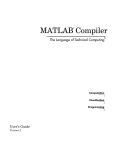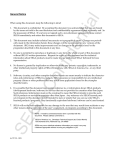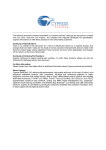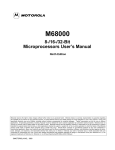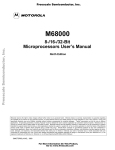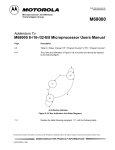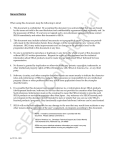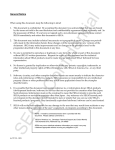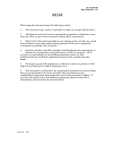Download Sega Saturn Technical Bulletin #51
Transcript
SEGA SATURN TECHNICAL BULLETIN # 5 1 (PRELIMINARY) To: Sega and Third Party Developers From: Developer Technical Support Date: January 22, 1997 Re: Restrictions for the MC68EC000 Sound CPU and the SCSP Restriction 1. Instructions that cannot be used with the MC68EC000 Sound CPU The following instructions codes cannot be used in programs for the 68000 Sound CPU installed in the Sega Saturn: RESET instruction TAS instruction Details ¥ The above instructions are not supported in the Sega Saturn. Consequently, an incompatibility error may occur if the instructions are used. If the Sound CPU and the SCSP must be reset, always have the SMPC issue the reset command from the main system. ¥ Reference Hardware Manual Volume 1, SMPC User's Manual, Chapter 2, "SMPC Commands" 2.3 System Management Commands for Resetting ¥ SNDON (sound ON) ¥ SNDOFF (sound OFF) ¥ Supplement Incompatibility errors do not occur if the application uses the sound driver provided by Sega. However, this restriction must be strictly observed for applications that use other sound drivers for the 68000. 1 Restriction 2. Prohibition of extended stop time for the MC68EC000 Sound CPU Stopping the Sound CPU for a longer period than necessary is prohibited. Details ¥ Conditions under which the Sound CPU can be stopped: The Sound CPU can be stopped only while a program (such as the sound driver) for the Sound CPU is being loaded to the sound RAM. Stopping the Sound CPU is prohibited at all other times. ¥ Stopping procedure: To stop the Sound CPU, use the Sound OFF command, which is one of the SMPC commands. To start the Sound CPU, issue the Sound ON command, which is also one of the SMPC commands. <Note> Using any other method to stop or start the Sound CPU is strictly prohibited. ¥ Supplement 1 When loading the sound driver, start the Sound CPU immediately after loading is completed. Sound driver startup must not be delayed due to other processes. The same applies on Sound CPU is restarted. ¥ Supplement 2 Do not stop the Sound CPU even if the main system (SH2) is using the sound driver or if the Sound CPU has nothing to process. In these cases, have the Sound CPU execute a program that loops endlessly. (For detailed instructions, refer to the SMPSYS.C sample program in IP.BIN.) ¥ Supplement 3 The following functions are found in the SEGA_SND.LIB, SEGA_SND.A, and LIBSGL.A libraries presented by Sega: SND_Init() SlInitSound() Users who use these functions to initialize and start the Sound CPU and the SCSP can disregard this restriction because the initialization 2 and startup processes are executed in the library function. However, users who use other functions to initialize and start the Sound CPU and the SCSP must strictly observe this restriction. ¥ Modifications in the related manual Target: Hardware Manual Volume 1, SMPC User's Manual, Chapter 2, "SMPC Commands" Remarks column for No. 4 SNDON (Sound ON) Old description: None New description: Issue this command immediately (within 0.5 seconds) after loading of Sound CPU execution program is completed. If the Sound CPU is stopped and access to the sound RAM from the main system is delayed, the operation of the sound RAM and the SCSP is not guaranteed. Use a library function to issue this command. Remarks column for No. 5 SNDOFF (Sound OFF) Old description: This command saves the contents of the sound memory (4 megabytes DRAM) even when the Sound CPU is set to OFF. New description: Do not use this command except to load the execution program for the Sound CPU. If the Sound CPU is stopped and access to the sound RAM from the main system is delayed, the operation of the sound RAM and the SCSP is not guaranteed. Use a library function to issue this command. 3



